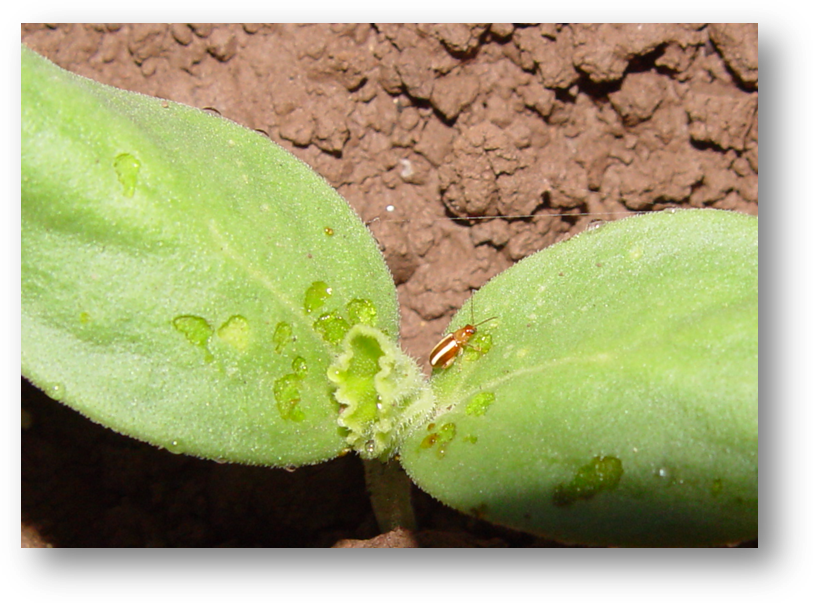
|
|
|
|

|
|||
|
|
|||
It’s that time of the year again. Desert growers have begun planting fall melons,
transplanting cabbage and will be direct seeding produce crops in just a few weeks.
Accordingly, PCAs and growers will be faced with a number of important insect management
issues. As crops begin to emerge, you can expect to encounter a number of insect
species that have the potential to cause serious economic losses to crop stands.
These include flea beetles, crickets (sometimes grass hoppers), darkling and rove
beetles, and saltmarsh caterpillars (‘woolly worms’). These insects all have chewing
mouthparts and most are capable of consuming large amounts of leaf tissue in a short
period of time. Seedling crops at the cotyledon stage are most susceptible, and
feeding by these pests can devour much of the cotyledons or outright kill small
plants. If left unprotected, larger seedling plants (1-2 leaf stage) can sustain
significant feeding damage on the terminal growing points or newly emerged leaves.
Not only can this feeding stunt plant growth, but can result in lack of stand uniformity
and maturity at harvest. Host sources of flea beetle, cricket and "woolly worm"
infestations include numerous summer crops (e.g., sudan grass, cotton and alfalfa)
and weeds (e.g., purslane). Recently, we’ve observed high numbers of flea beetles
and crickets at the Yuma Agricultural Center, and received reports of saltmarsh
caterpillars on pima cotton. Experience indicates that melon fields planted adjacent
to these crops/weedy areas are at a high risk from these seedling pests, particularly
flea beetles. As summer crops are harvested or terminated during the next several
weeks, these seedling pests typically move to the next available host crop; lettuce,
cole crops and melons. Fortunately, there are many registered insecticide alternatives
available that can be applied via sprinkler chemigation (i.e., pyreethroids) or
foliar sprays (i.e., methomyl, neonicotinoids) that can cost-effectively minimize
their abundance and damage to emerging produce and melon crops. Additionally, seed
treatments are available for lettuce and cole crops that will protect stands from
flea beetles. For more information on insect pests of leafy vegetables and melons
at stand establishment please see:Insect
Management on Desert Produce and Melons: Pests at Stand Establishment.

Pale-striped flea beetle
Remember, When in Doubt . . . . . “SCOUT”
Click picture to listen to John’s update
To contact John Palumbo go to: jpalumbo@ag.arizona.edu |
|||
| Back | |||
|
For questions or comments on any of the topics please contact Marco Pena at the Yuma Agricultural Center.
|
|||
|
Home |
Cotton | Veggies |
Forages | Grains
| Citrus |
Crop x Crop Insects | Diseases| Weeds | Pesticides | Economics | News | Weather | Research | Photos | Contacts | General Info. Copyright © 2001 University of Arizona, College of Agriculture and Life Sciences Webmaster: Al Fournier (acis@ag.arizona.edu) |
|||
